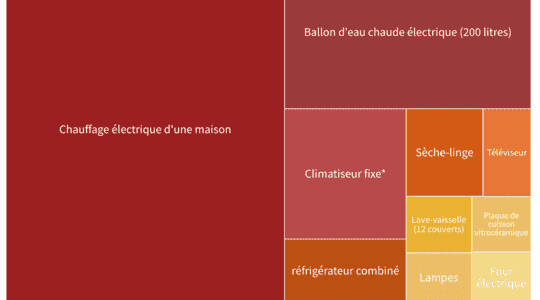With inflation, the energy crisis and the climate crisis, more and more French people are turning into apprentice accountants. They track kilowatt hours, price fluctuations and the best time slots to avoid the financial (and climate) pit. In order to avoid potential cuts this winter, the government is updating an old EDF offer, called “tempo”. Having fallen into disuse with the abundance of low-cost energies, it made it possible to obtain advantageous rates in exchange for voluntary reductions in consumption during peaks in demand linked to the cold.
Concretely, EDF will send an SMS to the customers concerned to tell them to slow down. In order to adapt to this particular context, it is still necessary to be well informed. The indicators available are as numerous as they are intimidating. And lingering over the labels of all the electrical appliances in one’s possession to try to extract a balance sheet remains very tedious. To see more clearly, L’Express has painted an overview, in three infographics, of the average expenditure of a household on energy, according to several official sources.
23 million homes are heated by gas or electricity
To understand why the government promotes “sobriety” in terms of energy, we must first look at what type of energy French homes consume to keep warm in winter. While a few million households heat with wood, heater urban where, thanks to heat pumps, two sources of energy are required, according to the Ministry of Ecological Transition: electricity, which heats around 11 million homes, and natural gas, which supplies 12.2 million.
These two sources of energy have seen their prices soar. On the one hand because demand has increased sharply due to the post-Covid-19 recovery, on the other hand because it is no longer possible to continue buying Russian gas, due to the war in Ukraine and Western sanctions. Heating this winter will therefore be more expensive than in previous years.
Heating, the main item of electricity consumption
Especially since heating is the main item of household energy consumption, far ahead of the others. It alone sucks up on average 27.6% of the energy consumed by a household in France, according to an Ademe report published in 2019. Next come cold appliances (refrigerator, freezer) and washing appliances, which represent 18.5% of household electricity usage. Then, almost at the same level, hot water, multimedia and IT, and small household appliances (vacuum cleaner, coffee maker…).
Electric heating sucks up an average of 733 euros per year
The most expensive appliance in a house is therefore, unsurprisingly, the electric heater. According to a study by Ademe based on EDF’s regulated tariffs in July 2022, it comes down to households, on average, at 733 euros per year. The hot water tank costs 285 euros on average. Then comes the air conditioner, which if it is not yet common in France, can cost up to 120 euros per year. The combined refrigerator is the third most expensive object in terms of electricity. It captures 59 euros per year, 8 more than the dryer.
Based on this observation, Ademe has issued several recommendations to lower the bill. When a household appliance breaks down, replacing it with a low-consumption appliance can really make a difference, even if it is more expensive to buy. Another issue, even more massive: a well-insulated home can drastically reduce energy consumption. To speed up the renovations, the State offers aid. Finally, some small gestures can help. For example, a defrosted refrigerator works much more efficiently. Enough to save a few euros at the end of the year.
